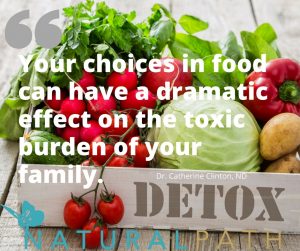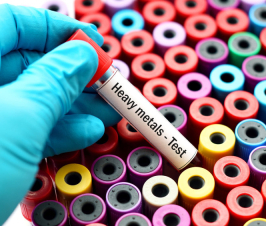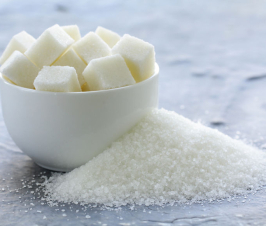This time of year people are looking to get healthy.
 There’s lots of talk about detoxes or cleanses and the talks range from utter nonsense to important steps you can take to address environmental pollutants. Industrial chemicals, pollutants and pesticides are major contributors to chronic diseases like cancer, diabetes, autoimmune diseases and neurocognitive diseases in children and adults. (1)
There’s lots of talk about detoxes or cleanses and the talks range from utter nonsense to important steps you can take to address environmental pollutants. Industrial chemicals, pollutants and pesticides are major contributors to chronic diseases like cancer, diabetes, autoimmune diseases and neurocognitive diseases in children and adults. (1)
“The World Health Organization warns that chronic, noncommunicable diseases are rapidly becoming epidemic worldwide. Escalating rates of neurocognitive, metabolic, autoimmune and cardiovascular diseases cannot be ascribed only to genetics, lifestyle, and nutrition; early life and ongoing exposures, and bioaccumulated toxicants may also cause chronic disease. Contributors to ill health are summarized from multiple perspectives—biological effects of classes of toxicants, mechanisms of toxicity, and a synthesis of toxic contributors to major diseases. Healthcare practitioners have wide-ranging roles in addressing environmental factors in policy and public health and clinical practice. Public health initiatives include risk recognition and chemical assessment then exposure reduction, remediation, monitoring, and avoidance. The complex web of disease and environmental contributors is amenable to some straightforward clinical approaches addressing multiple toxicants. Widely applicable strategies include nutrition and supplements to counter toxic effects and to support metabolism; as well as exercise and sweating, and possibly medication to enhance excretion. Addressing environmental health and contributors to chronic disease has broad implications for society, with large potential benefits from improved health and productivity.”
Some detox programs use strong metal chelators that pull toxins out of tissues while others restrict calories with juicing or fasting, making certain detoxes inappropriate for the part of society that are most vulnerable to toxins- children. A study from 2005 showed over 250 industrial chemicals, pollutants and pesticides in the umbilical cord blood of newborns. (2) Industrial toxins are everywhere and something we should all be addressing for a healthy lifestyle.
Here are some easy steps to help detox that the whole family can do:
Do a Cleanse
An important piece of any cleanse is getting rid of toxins in the body. Common food additives and food packaging contain chemicals. These chemicals have been linked to everything from hormone disruption to cancer to behavioral issues in children. (3) Whether a short term cleanse or a daily meal selection, your choices in food can have a dramatic effect on the toxic burden of your family.
- Eating fresh food and avoiding packaged, processed food is an easy way to reduce the toxin burden of the whole family. A recent study showed that avoiding food packaged in plastic and canned food for as little as three days can dramatically reduce the levels of BPA and DEHP (chemicals associated with hormone disruption and cancer) in the body. Participants avoided packaged foods in their diets for three days and saw a reduction in these chemicals by over 50%. (4)
- We know that an organic diet decreases exposure to chemicals and pesticides. A diet based in organic fruits, vegetables and grains help avoid these toxins. Organic dairy and wild fish are also important choices when trying to reduce your family’s toxic burden. The Environmental Working Group analyzes Department of Agriculture data about pesticide residue and ranks foods based on how much or little pesticide residue they have. The group estimates that people can reduce their exposure by 80% if they switch to organic when buying these 12 foods: apples, celery, strawberries, peaches, spinach, nectarines (imported), grapes (imported), sweet bell peppers, potatoes, blueberries (domestic), lettuce, kale/collard greens. (5)
Detox Your House
Several things can be done around the house to lessen the toxic load in your home and personal care products.
- There are low emission options for carpets, bedding, paints and furniture that can reduce your family’s exposure to chemicals.
- Choosing cosmetics and personal hygiene products that are free of mineral oil, paraffin, propylene glycol, parabens and phalates limit your family’s contact with these toxins. There are many natural, organic cosmetic and personal hygiene lines for the whole family.
- Adding certain plants to your household can help filter toxins out of the air making house plants a beautiful way to detox your house. (6)
- Start by choosing green products or making your own. Many cleaning products on the market today contain harsh chemical cleansers but there are many green cleaning products available as well. Making your own cleaners can be as simple as utilizing the power of vinegar, baking soda and water.
- Cleaning out your air ducts, changing your furnace filters regularly with high quality pleated filters and not wearing shoes inside can decrease the amount of dust in the house. The toxins we want to avoid are actually in the dust. Using a hepa filter for vacuuming can also reduce the amount of dust and therefore limit toxin exposure in your family.
Get Moving and Sweaty
Whether you want to rid the body of heavy metals or manmade chemicals, sweating is an easy and natural way to make sure you are getting rid of those toxins. While some detoxification programs call for saunas and profuse sweating that would not be suitable for the entire family, gentle sweating is a safe and easy way to boost the body’s detoxification processes.
- There is a lot of research showing that simply sweating can be one of the most powerful ways to detox from these industrial pollutants. Drink plenty of fluid to replace any fluid lost while sweating. (7, 8, 9)
- Regular exercise helps rid the body of toxins as well. Exercise not only gets blood and lymph circulation moving to help remove toxins but the breath can also be a great way to detox through movement. Some exercise and a little sweat is a great way to detox. (10)
Whether it is a three-day cleanse with fresh food or choosing green cleaning products the next time you buy supplies, these simple tips can help lower your family’s chemical burden today!
References:
(1) Environmental Determinants of Chronic Disease and Medical Approaches: Recognition, Avoidance, Supportive Therapy, and Detoxification. Margaret E. Sears and Stephen J. Genuis J Environ Public Health. 2012; 2012: 356798.
(2) A BENCHMARK INVESTIGATION OF INDUSTRIAL CHEMICALS, POLLUTANTS AND PESTICIDES IN UMBILICAL CORD BLOOD. Environmental Working Group, July 14, 2005
(3) Bisphenol A and human health: a review of the literature. Rochester JR. Reprod Toxicol. 2013 Dec
(4) Plastics and Food Sources: Dietary Intervention to Reduce BPA and DEHP. Kellyn S. Betts. Environ Health Perspect. 2011 Jul 1; 119(7): a306.
(5) http://www.ewg.org/
(6) Planting Healthier Indoor Air. Luz Claudio. Environ Health Perspect. 2011 Oct; 119(10): a426–a427.
(7) Arsenic, Cadmium, Lead, and Mercury in Sweat: A Systematic Review. Margaret E. Sears, Kathleen J. Kerr, Riina I. Bray. Journal of Environmental and Public Health. Volume 2012 (2012), Article ID 184745
(8) Human Elimination of Phthalate Compounds: Blood, Urine, and Sweat (BUS) Study. Stephen J. Genuis, Sanjay Beesoon, Rebecca A. Lobo, Detlef Birkholz. Scientific World Journal. 2012; 2012: 615068.
(9) Human Excretion of Bisphenol A: Blood, Urine, and Sweat (BUS) Study. Stephen J. Genuis, Sanjay Beesoon, Detlef Birkholz, Rebecca A. Lobo. J Environ Public Health. 2012; 2012: 185731.
(10) Effect of physical exertion on the biological monitoring of exposure to various solvents following exposure by inhalation in human volunteers: II. n-Hexane. Tardif R, Nadeau V, Truchon G, Brochu M. Journal of Occupational and Environmental Hygiene. 2007;4(7):502–508.
 Catherine Clinton ND, is a graduate of the National College of Natural Medicine (NCNM) in Portland, Oregon. She is a board licensed naturopathic doctor currently practicing at her private clinic in Eugene, Oregon.
Catherine Clinton ND, is a graduate of the National College of Natural Medicine (NCNM) in Portland, Oregon. She is a board licensed naturopathic doctor currently practicing at her private clinic in Eugene, Oregon.
Dr. Clinton is a speaker on integrative medicine and gut health and has authored several publications in those areas. She is founder of WellFuture, a line of nutritional supplements for infants and children that uses organic, whole food ingredients and the greenest, bioavailable nutrients.
When in medical school Catherine was diagnosed with an autoimmune disease that effects the gastrointestinal tract, leaving her with a special interest in autoimmune diseases and gastrointestinal conditions. Accessing how the multiple systems of the body are working together is a vital piece of Dr. Clinton’s practice. With a practice focused on gastrointestinal and immune health Dr. Clinton utilizes the latest in functional medicine combined with nutrition, herbal medicine and lifestyle interventions to treat a variety of digestive complaints, autoimmune diseases and pediatric conditions.
With the birth of her own children Dr. Clinton became passionate about the prevention of these chronic diseases and conditions by addressing the immune systems and gastrointestinal health of our children. Catherine is deeply committed to the optimal health of babies, children and families everywhere and loves to interact with her readers through her blog and social media.

















